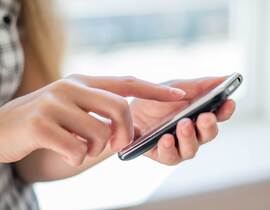 For better or worse, we’re all tethered to our phones. So why not use this to your advantage? According to research from the Local Project, text is the most commonly used form of communication for American adults under 50. The online marketer 99Firms found that the open rate for text messages is 99 percent, as compared to 17-28 percent for emails. Texts get attention, yet according to the communications firm MessageDesk, only 60 percent of marketers use them to interact with guests and build stronger connections with them. Consider the potential uses of text in your business. The Rail suggests using text to share discounts and specials, personalized promotions, loyalty rewards updates, and survey requests. You could also harness text to manage communications about reservations, send guests updates about the availability of their table, or to streamline curb-side pickup. At a time when restaurant operators are concerned about cutting costs where possible, texting is a cost-effective way of reaching guests at scale and targeting them with segmented messages. They are also easy to automate, so you’re setting yourself up to connect with guests on auto pilot. Just make sure you’re not bombarding your recipients with messages and that the ones you send contain information that’s actionable and valuable.  Text messages have become the digital communication vehicle of choice for many restaurants and it’s easy to see why: According to Gartner research, text open and response rates are as high as 98 percent and 45 percent, respectively – compared to 20 percent and 6 percent for email. The text medium can be a useful vehicle for alerting waiting guests that their table is ready, sending online menus, or making people aware of just-in-time offers or updates about their loyalty program status. But while email has become easier to ignore and more businesses are relying on text to reach consumers in the moment, this text-heavy environment makes it that much easier for the recipient of a text to choose to block the sender. So making your texts targeted, worthwhile and as distinct from spam as possible will help you maintain a high level of access to the people you want to reach. As a recent report from Modern Restaurant Management advises, make sure you’re sending texts to the appropriate audience (if you have locations in multiple cities, you obviously need to separate your distribution lists for those regions, but try to segment even further). Try to make your messages personal and specific, using the person’s name and the name of your restaurant so your message isn’t readily overlooked. If you’re sending a link, such as the link to your menu, you’ll come across more credibly if you include the full, identifiable link and not a shortened version. Finally, include in each text an option allowing recipients to opt out. It may seem counterintuitive to make it easy for people to unsubscribe, but you’re only going to be able to get through to people who are open to hearing from you.  The habits and tastes of the couple who dines with you on a Friday night are likely much different from those of the parent who brings his child in for lunch with you on a Saturday. So your outreach to these guests must be different too. As Paytronix CEO Andrew Robbins recently said, “Fifty percent of people are day-dependent. The day they make a purchase is hugely important.” Getting the day right when communicating offers to them, he says, can make marketing to these guests 50-58 percent more effective. Your loyalty program, therefore, should be able to make guests feel like you’re interacting with them personally (without them noticing you’re doing so at scale). For example, if a guest loves getting takeout from you on a Friday night and she tends to ignore emails, you’ll have an easier time securing her order if you tempt her on a Friday afternoon with a text message that includes a link to (and even a visual of) her favorite order. It’s a much easier “yes” than a blanket email for a new lunch combo deal – though directing that to a certain subset of your guests may work perfectly. When you get guests to sign up for your app or to other forms of communication from you, how far are you able to drill down on their habits and preferences? Consider not just what they like to eat but when, why and how they like to hear from you. More data from them should equal more detailed customization from you.  Texting, as a means of connecting with guests, has a number of critical benefits: It’s an intuitive technology that everyone – regardless of demographics – knows how to use. It doesn’t require a download, so there is little commitment involved. Finally, it’s that rare technology that has the power to immediately get the attention of the recipient: It’s common to ignore an email, call or social media alert – but not a text. In fact, the click-through rate for text offers is more than 9 percent higher than any other digital channel, according to TechJury. So are you using text messaging to its fullest potential? Once your guests opt into it, ensure you’re using text to send important, just-in-time offers – don’t bombard them with untargeted promotions that will quickly become noise. Offer discount codes good for a future order, an invitation to a special event, contest or tasting, a birthday treat, or a prompt to reengage a customer who hasn’t ordered in recent weeks.  Consumers are significantly more apt to read a text than an email. In fact, according to the Mobile Consumer Engagement Study 2020, 40 percent of consumers say they have at least 50 unread emails. Ten percent say they have more than 1,000 such emails. On the flip side, only 4 percent of consumers say they have 50 or more unread mobile text messages. Knowing this, how can you use texts to drive guest engagement? Could you use them to send a location-specific promotion of your popular mozzarella sticks before a big game? Ping a request for an online review immediately following a dine-in meal? What key guest actions could you best encourage with a brief message that gets immediate attention? It’s Friday afternoon and just as you’re starting to get hungry and think about what’s for dinner, your phone pings you with a text offer from your favorite pizza place. Even though you hadn’t been thinking about pizza, suddenly this restaurant has jumped to the front of the line of potential restaurants where you consider ordering take-out. This year, more restaurants are putting themselves in a position to win business like this as the competitive landscape for restaurants has matured and broadened. Restaurants now need to stand out from not only other brick-and-mortar restaurants but also from ghost kitchens and even competition in the form of grocery stores, meal kit companies and even gas stations vying for foodservice business. A well-timed text can help. But in order for restaurants to craft SMS marketing campaigns that target the right customers at the right times, they first need a strong SMS database of contacts. Make sure that at your restaurant, you’re not leaving any gaps where contact information can be collected. In-store, ask customers during a purchase if they want to receive promotional offers from you via text. If you send an email newsletter, use those communications to prompt recipients to opt into texts and access special deals. If you take orders on your website, ask customers to tick a box as part of the checkout process to receive the promotions. Finally, use your social media platforms to promote your text promotions – try posting a dedicated number or key word that viewers can text to easily opt into your offers.
|
Subscribe to our newsletterArchives
March 2024
Categories
All
|




 RSS Feed
RSS Feed